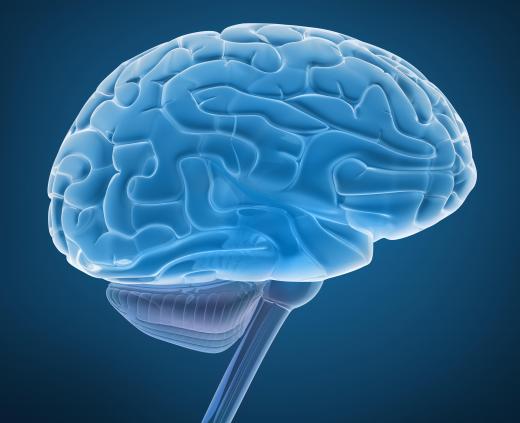What is the Main Cortex Function?
 Mary McMahon
Mary McMahon
The cerebral cortex, also known as the main cortex or simply cortex, is the part of the brain which handles so-called “higher order thought.” This structure is present in the brains of many animals, but humans have an unusually large and well developed cerebral cortex. The advanced functions of the human cerebral cortex are the thing which set humans apart from other animals.
As many people are aware, the cortex is divided into two halves, known as hemispheres, and each hemisphere is responsible for an array of functions. There is some duplication, in which both hemispheres perform the same activity, but other cortex functions may be limited to only one hemisphere. Intriguingly, if people experience brain damage when they are very young, their brains can remap themselves to restore a cortex function which would have otherwise been lost.

There are four areas in the cerebral cortex: the frontal, parietal, occipital, and temporal lobes. The temporal lobe is responsible for cortex function related to auditory perception, language, and memory. The occipital lobe is dedicated to processing visual information, while the parietal lobe handles voluntary movement, spatial orientation, touch, and processing of numbers.

The cortex function of the frontal lobe is especially critical. This lobe of the cerebral cortex is involved in emotions, problem solving, critical thinking, the ability to plan, and the recognition of parts of speech. Often, these areas are active simultaneously, interacting to interpret and respond to stimuli. Vast numbers of connections can be found in the brain to coordinate brain activity, and the human brain in particular has an especially complex network when compared to the brains of other animals.

This breakdown of cortex function is a bit simplistic. In fact, interaction between different lobes is needed almost constantly to cope with stimuli, and things like language are not necessarily isolated to different parts of the brain. For example, different parts of the brain activate when people work with ideographic or alphabetic writing systems. In fact, some studies have uncovered people who are dyslexic in one writing system but not in another, or who incur brain damage which prevents them from writing in one system, but allows perfect literacy in another.
Information about cortex function comes from a number of sources. Brain scans can be used to look at the cortex while it is active to see which areas are the most active, and detailed case records on people who have incurred brain damage have also provided a great deal of useful information. People who study the brain are always uncovering new and interesting information about how it works.
AS FEATURED ON:
AS FEATURED ON:













Discussion Comments
I think you all have a point there because of the personal side to people and their patterns of thinking and brain processes!
TrogJoe19: Don't want to start an argument, but that is Freud's theory from the beginning.
@TrogJoe19
I think that these comprise the "imago dei" which links us to higher archetypes and psychological draws. It can also be dangerous and lead to schizophrenia if we are not careful to monitor and control the brain. Schizophrenics have the issue of extreme introspection, to the point where the regions of their brain which are inward focused (used in dreams, ideas, etc.) begin to dominate the outward-focused parts of the brain and make their own reality. It is like dreaming awake.
I think I would agree with the model that Jung put forward concerning three different levels of the human psyche. There is the id, which is the animal region, the ego, which is the person's conscious sense of self, and then there is the superego, which is the larger societal region of self-understanding in the larger context. These seem to correspond with stages in the evolution of the human mind. The regions of the brain which are farthest from the cerebellum comprise the superego, or societal understanding of morals and higher beliefs. These are truly the pinnacle of human existence.
As far as I'm concerned, animals to not have this higher conscious thought. They rely on what we would call the subconscious urges of nature and instinct. They do not innovate new things on top of these basic urges, but do learn to respond differently to varying situations. We as humans are much more "godlike" in these animals in our capacity to see patterns and innovate. We manipulate nature and spread like a virus.
Post your comments